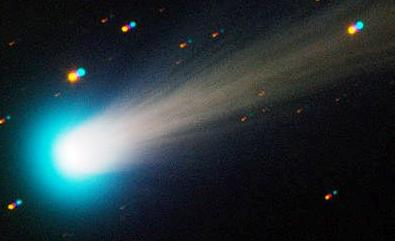 What neighborhood? Mine? Yours? I’m actually referring to both of our neighborhoods and a good deal more. I’m talking about the Solar System, and not just out to Neptune or Pluto but a thousand times farther–out to the Oort cloud of would-be comets.
What neighborhood? Mine? Yours? I’m actually referring to both of our neighborhoods and a good deal more. I’m talking about the Solar System, and not just out to Neptune or Pluto but a thousand times farther–out to the Oort cloud of would-be comets.
How many would-be comets are lolling about in the outer neighborhood of the Solar System? Probably several trillion, give or take a decimal point. So many that they gravitationally jostle one another from time to time and occasionally one gets perturbed enough to drop out of orbit and fall toward the Sun. Half a million years later or so the comet finally reaches the inner Solar System–our local neighborhood of planets and moons. During that whole time, the comet has been accelerating so that when it reaches Earth’s neighborhood (about 150 million kilometers from the Sun = one Astronomical Unit), it is traveling about 42 kilometers per second (26 miles per second or 93,000 miles per hour).
You do not need to be particularly lucky to see one of these comets in your lifetime since comets visible to the naked eye arrive about once every year; you just need to know where and when to look.
In November, Comet ISON finally reached the Sun after half a million years and mostly broke up from heat and gravitational forces as it rounded our personal star. It missed us by 64 million kilometers–not even close.
That brings me to the crux of this post. Earth is an unwilling target in a cosmic pinball game. Comet ISON could have hit our Earth with the power of 33 megatons of TNT. That’s twice the energy of the most powerful United States H-bomb test. If it hit somewhere out over open ocean–the most likely occurrence–not much serious would happen. On the other hand, if it hit Las Vegas, the event would deal secularism a serious setback, as fundamentalists would undoubtedly tout it as the second divine eradication of Sodom and Gomorrah.
Comet ISON was less than a kilometer across and its density was only about half that of water. Comet 81P/Wild was 4 kilometers in diameter; Comet Tempel 1 about 6 kilometers; and Halley’s Comet about 10 kilometers–roughly the same size as the comet (or asteroid) that led to the extinction of non-avian dinosaurs and a whole lot more.
There’s no need to start wearing a Kevlar helmet just yet. With current technology, some comet hunter will likely spy any sizeable incoming Oort cloud emigrant twelve or more months before it gets here. Also, the chances that a large comet will hit the Earth in the next 100 years are finite but minuscule. Apparently the last time that happened was 65 million years ago.
Even though our neighborhood pinball machine is mostly empty space and collisions are quite rare, it would be a good idea to develop at least two capabilities. One would be to improve the equipment and technologies for spotting incoming comets in order to give Earthlings more than just a year to ponder the bad news. A second would be to design and prepare equipment that could reach and deflect an incoming comet that has our number on it.
Of course, the young-earth creationists at Answers in Genesis don't believe in the Oort cloud. They consider the Oort cloud a cheap invention by some astronomers to account for the continuing arrival of comets in their (incorrect) old-earth model. The Oort cloud is not necessary in a young-earth cosmos and, in that view, comets have never harmed life on Earth. In keeping with their "you weren't there" attitude, they claim that "[s]ince it cannot be detected, the Oort cloud is not a scientific concept." No astronomer has said that the Oort cloud "cannot be detected," rather it has yet to be detected. For example, most sub-atomic particles were similarly hypothesized decades before they were detected. The existence of the Oort cloud can readily be inferred from the velocities of incoming comets; velocities that have no explanation in a young-earth cosmos other than Goddidit. If you bought their line, you wouldn't see any possible reason to support scientific research and development that could in fact make the difference between humans hanging around a while longer or maybe not so long. Would it be too outrageous to conclude that accepting their brand of young-earth creationism will lead to a fiery death from the skies?
Links:
- NASA Near Earth Object Program
- European Space Agency NEO Space Mission Studies
- B612 Foundation
- International Astronomica Search Collaboration
- Comet's fiery demise may help scientists save Earth some day
